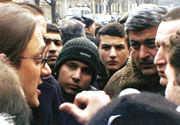
|
|
Der Film erzählt die Geschichte des post-sowjetischen Übergangs zur Marktwirtschaft anhand des Zusammenpralls der Kulturen, von Stromsperren und Stromausfällen. Die ‘AES Corporation‘, ein gewaltiger nordamerikanischer Energiekonzern, hat die privatisierte Elektrizitätsgesellschaft in Tbilissi erworben. Piers Lewis arbeitet als Manager bei dem Konzern und muss der ehemals kommunistischen Bevölkerung nun beibringen, dass in dieser neuen Zeit Kunden für ihren Strom bezahlen. Aber die Georgier denken sich immer raffiniertere Methoden aus, um kostenlos an Elektrizität zu kommen. [aus dem Forumprogramm] QUESTIONNAIRE 1 How would you describe the aesthetics of your film? I believe that just as there are many genres of fiction film (drama, comedy, thriller, etc.) there are many genres of nonfiction film. Documentary is only one genre of nonfiction. Rather than Documentary, I consider Power Trip to be a Nonfiction Narrative, which emphasizes storytelling, entertains as well as informs and applies a clear dramatic structure to nonfiction material. 2 Why did you choose to shoot on dv? DV is the clear choice for independent nonfiction filmmaking because of its relatively high quality at low expense. We shot or acquired almost 140 hours of DV tape for Power Trip. The expense of shooting this project on film would have been prohibitive, especially in the current difficult funding environment in the United States for independent documentary. Additionally the small size of the cameras allows for much easier access to certain subjects and situations. In short, shooting on DV is what made Power Trip possible. 3 What was special about shooting in dv (e.g.compared to 35mm, was it your first time with dv or are you used to it)? I have used DV before in a limited way, but this is the first project that was primarily shot on DV. The greatest thing about DV is that it allows for almost total independence. I was able to shoot most of Power Trip on my own, without need for a crew or sound person. It was edited at my home office and I was able to store all 140 DV tapes for the project on one shelf. (My last project overwhelmed me with large Betacam tapes.) 4 What was your shoot-edit ratio? We shot or acquired about 140 hours of footage. We digitized approximately 70 to 80 hours of that for the off-line. The final program is 84:40. 5 Would you have preferred to shoot in another format? If so which? Perhaps DVCAM as opposed to mini-DV. 6 Does using dv mean that you are considering other means of distribution opposing the established? If so which? Not necessarily, since we are finishing on 35mm film and DigiBeta. We'll see as opportunities arise. 7 One good word about dv (or two): Accessibility. Now, anyone can make a movie. 8 One bad word about dv (or two): Accessibility. Now, everyone IS MAKING a movie. [zurück zur DV-FILM ÜBERSICHT] [nach oben] |
